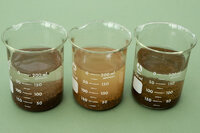Aqua sobriquet
Member
I read somewhere that some substrates increase TDS whilst other quite similar looking stuff actually reduces it. Although there are probably very good reasons for this it didn't seem particularly logical to me. Why for example, would two fired clay products react so differently?
Well I don't know why, but as I have a few different substrates to hand perhaps I could take some simple readings with my new TDS Meter just to satisfy my own curiosity! Nothing too scientific but it's not costing me anything except a few moments of my time.
This is what I've done. I have to hand three fairly similar looking substrates: JBL Manado, Tesco (moler clay) Cat Litter and Colombo Flora Base (small pellet)
I measured 50ml of each material and placed it into a beaker (unwashed) and topped it up with water. I used supermarket spring water with a starting TDS of 106. Not sure why but that's what I used! As a point of interest I weighed each dry 50ml sample with the following results: JBL Manado 40g, Tesco C/L 28g and Flora base 46g.
Others have noted that some substrates are attracted to a magnet so I put a small magnet into each dry sample in turn and found they all demonstrated this phenomenon. After gently adding the water I noted that the Manado sample went a little cloudy, the Tesco C/L went very cloudy and the Flora base stayed quite clear. 24 hours later and the Tesco sample still does not look completely clear but the other two look good, particularYly the Flora Base.
These are the start TDS readings of the samples:
Manado 131
Tesco 174
Flora Base 106
After 4 hours I took another reading:
138
184
101
24 hours after first reading:
170
222
91
----------------
204
290
85
----------------
238
370
86
----------------
273
408
86
----------------
307
486
86
----------------
327
528
89
----------------
348
578
89
----------------
355
599
88
---------------
375
650
88
---------------
403
690
90
---------------
I'll take readings now every 24 hours until I get bored or the readings level off - whichever comes first!
The samples, taken just after adding the water. For some reason they look clearer in the picture than they actually were:

Manado on the left, Tesco in the middle and Flora Base on the right.
Well I don't know why, but as I have a few different substrates to hand perhaps I could take some simple readings with my new TDS Meter just to satisfy my own curiosity! Nothing too scientific but it's not costing me anything except a few moments of my time.
This is what I've done. I have to hand three fairly similar looking substrates: JBL Manado, Tesco (moler clay) Cat Litter and Colombo Flora Base (small pellet)
I measured 50ml of each material and placed it into a beaker (unwashed) and topped it up with water. I used supermarket spring water with a starting TDS of 106. Not sure why but that's what I used! As a point of interest I weighed each dry 50ml sample with the following results: JBL Manado 40g, Tesco C/L 28g and Flora base 46g.
Others have noted that some substrates are attracted to a magnet so I put a small magnet into each dry sample in turn and found they all demonstrated this phenomenon. After gently adding the water I noted that the Manado sample went a little cloudy, the Tesco C/L went very cloudy and the Flora base stayed quite clear. 24 hours later and the Tesco sample still does not look completely clear but the other two look good, particularYly the Flora Base.
These are the start TDS readings of the samples:
Manado 131
Tesco 174
Flora Base 106
After 4 hours I took another reading:
138
184
101
24 hours after first reading:
170
222
91
----------------
204
290
85
----------------
238
370
86
----------------
273
408
86
----------------
307
486
86
----------------
327
528
89
----------------
348
578
89
----------------
355
599
88
---------------
375
650
88
---------------
403
690
90
---------------
I'll take readings now every 24 hours until I get bored or the readings level off - whichever comes first!
The samples, taken just after adding the water. For some reason they look clearer in the picture than they actually were:

Manado on the left, Tesco in the middle and Flora Base on the right.


